“Sleep tight, and don’t let the bedbug bite,” was a common saying when I was a kid, but I did not really understand it. What was a bedbug anyway? I thankfully went through most of my life without knowing because they were largely eradicated as pests throughout the developed world. However, since the 1990s they have been on the rise.
Bedbugs are parasitic insects in the true bug order Hemiptera. Like other true bugs, they have piercing mouthparts, but unlike most other bugs, bedbugs use them to pierce you and suck your blood. While feeding, the bedbug injects its victim with an anticoagulant saliva. They can live for long periods between meals, but prefer to feed once every five to ten days.
The adult bedbugs are large enough to be easily seen. They are about 1/8 of an inch long and dark brown in color. Their bodies are rounded and flattened front to back. Younger nymphs are small and clear. Bedbugs live in large groups, usually close to their food source, and with a food source their numbers can balloon very quickly. They can be easily transported on clothing, luggage, or furniture and in this way are easily spread from place to place. Infestations can be very hard to detect and eradicate. In recent years dogs have been trained to detect infestations and can do so much faster than a human exterminator in most cases.
Signs of bedbugs include blood spots on the bedding, molted skins of the bugs themselves, clusters of droppings, and the bugs themselves hiding in mattress folds or in the box springs. There is still a stigma about infestations as many people assume that an infestation means the home is unclean, and this stigma means that infestations may not be reported. Hotels increasingly have issues as they serve many people from all over, and once infested, the travelers can carry the bugs home.
Bedbugs feed mostly at night, and they will attack any exposed skin. Bites are not felt at the time, and after feeding for about 10 minutes the bug goes back to hiding. Later, the bites might welt and itch. Sometimes they occur in a line of bites, and are often mistaken for bites from other insects like fleas or mosquitoes, or some other skin rash. This is one reason that infestations can persist for long periods without detection.
You do not have to live with bedbugs however. Getting rid of an infestation is generally not easy, and usually involves a professional exterminator. All areas where the bugs occur should be cleaned and vacuumed. Clothing and bedding should be washed to kill eggs and larva. The bugs will live on mattresses and box springs, behind headboards and in furniture, behind picture frames, and in crevices like around baseboards. Clearing up clutter around the bed is also a good idea. Getting to all the areas where the bugs could be hiding is very difficult. An exterminator will spray insecticides which should be used only as needed since they will be applied to bedding and carpets that you come in contact with too. There is evidence that the bugs are becoming resistant to common insecticides, which is a source of concern.
Be aware. Early detection helps keep infestations from becoming more difficult to deal with. These days more people understand the meaning of “don’t let the bedbugs bite” as these pesky house bugs make a comeback.
A good reference with lots of photos can be found at bedbugger.com. Also check out the story on Fresh Air.
